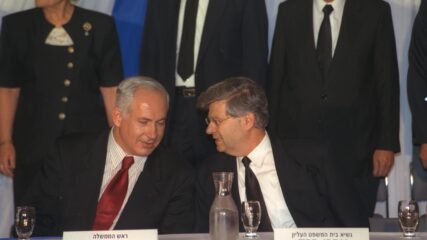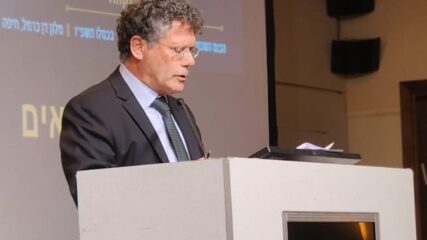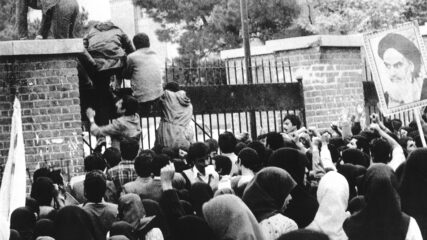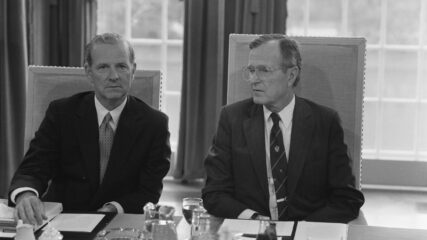March 28, 2002
Printable PDFAt the March 2002 Arab Summit in Beirut, then Crown Prince Abdullah of Saudi Arabia laid out five points to “end” the Arab-Israeli conflict. New York Times columnist Thomas Friedman had revealed details of Abdullah’s initiative on February 17, 2002. At the summit itself, held on the 27th and 28th of March, Abdullah presented the plan and the Arab League adopted a revised version.
The resolution called on Israeli withdrawal to pre-1967 lines, including a withdrawal from southern Lebanon; the resolution of the refugee problem according to the stipulations of UNGA 194; and the establishment of a Palestinian state on all of the West Bank and Gaza, with East Jerusalem as the capital. For their part, Arab countries would consider the Arab-Israeli conflict ended; enter into a peace agreement with Israel; and establish normal relations with Israel in the context of this comprehensive peace.
Significant details in the text included the specific mention of the Golan Heights as one of the territories to be returned from 1967. This area was the only one singled out, evidence of Syria’s desire to avoid having the Palestinian issue, namely discussion of the West Bank and Gaza Strip, overshadow its own territorial insistence of the return of all the Golan territories taken in the June 1967 War. Importantly, the Syrian view reflected Bashar Assad’s willingness to engage the Israelis, if all Syrian lands could be returned, but that prospect had limited possibilities. Yet once again, like Sadat had done in the mid-1970s, he was willing to engage the Israelis if all of his land could be returned, and perhaps at the sacrifice to Palestinian interests. Like his father, Bashar Assad had little political affection for Yasser Arafat.
Historical Context: The First Saudi Plan (1981-1982)
The manner in which the Saudis presented their initiative in 2002 was not new. In August 1981, Saudi Arabia’s King Fahd participated in a wide-ranging interview with the official Saudi Press Agency, in which he outlined an 8-point plan for a comprehensive settlement of the Palestinian issue. Just as the Saudis did in 2002, Fahd floated his ideas to the general Arab public with the help of the media in advance of an upcoming Arab Summit. In 1981, the Arab Summit was held in November, but it was cut short because of Syrian objection to the proposed Saudi plan. That summit reconvened in September 1982, at which point the Arab League adopted a revised version of Fahd’s plan. Incidentally, it was Crown Prince Abdullah – not Fahd – who, in the wake of the August 1981 interview, clarified the plan before the press. On a point of great significance in the context of the conflict, he explained that Fahd’s plan did imply recognition of Israel, which, against the backdrop of Saudi rejection of the Camp David Accords, marked a turning point vis-à-vis the Saudis.1
Context of the 2002 Arab Initiative; The Second Saudi Plan
In early 2002, as the United States laid the groundwork for war in Iraq (Bush’s “Axis of Evil” State of the Union address was delivered in January 2002), Abdullah, in part endeavored to divert U.S. attention from the fact that 13 of the 9/11 hijackers were from Saudi Arabia. He did so by focusing the discussion on Arab-Israeli affairs, with a declared intent for the Arab League to offer Israel full diplomatic relations, normalized trade and security guarantees.2
Beyond September 11 and the pending war in Iraq, the initiative came at the height of the second Intifada, which followed the collapse of the high-stakes peace negotiations that took place at Camp David (2000) and Taba (January 2001). This context is what made the plan, with its impossible demands in exchange for significant Arab concessions, irrelevant. Not only was hard-line Ariel Sharon already in office as Israeli Prime Minister, but the initiative was quickly overshadowed by the devastating Passover bombing at the Park Hotel by the Hamas military wing in Netanya (March 27, 2002) and the subsequent launch of Israel’s Operation, Defensive Shield (March 29, 2002). Sheikh Yasin, then the head of Hamas, made it clear that the attack in Netanya was a message for the Arab League that the Palestinian people would continue to use armed struggle against Israel.
Politics of the 2002 Arab Summit
Even before the summit in Beirut, competing interests dictated the unlikelihood of the weight of Arab unity yielding an effective resolution. In the preceding weeks, Sharon stated publicly that if Palestinian leader Yasser Arafat attended the summit, he might not be allowed to return to Ramallah. Adding to the story was news of other forthcoming summit absences: Egyptian President Hosni Mubarak, who cited solidarity with Arafat; Jordanian King Abdullah, citing exhaustion in one report and security concerns in another; and the Heads of State for Qatar, Kuwait, Iraq, Oman, Libya, and Mauritania.3 Only ten of twenty-two Arab leaders attended this summit.
On top of the forced absence of Arafat, the Palestinians suffered another humiliation when Lebanese President Emile Lahoud made a surprise change to the schedule. On the first day, Arafat was scheduled to address the summit via videoconference. When Syrian President Bashar Assad finished speaking, Lahoud, instead of introducing Arafat, called on someone else instead. In protest, the Palestinian delegation walked out.
Lahoud later made various vague excuses for his actions, but analysts speculated that he was bowing to Syrian pressure to derail the Saudi proposal, which had been laid out just before Assad’s presentation.4 Inter-Arab politics swirled about the summit with one Arab state seeking to upstage another. While formulas about the Palestinian future were offered, the Palestinians were not speaking on their own behalf. And yet, Palestinian negotiators had in 2000-2002 agreed on numerous points with Israeli negotiators while the Arab initiative, for its part, was more inflexible vis-à-vis the Israelis.
Palestinian negotiators at Camp David in July/August 2000, at Taba in 2001 and up to the Arab initiative had, for example, said that instead of a Palestinian capital in East Jerusalem, they would instead settle for Arab neighborhoods becoming part of the Palestinian state, with Jewish neighborhoods remaining a part of Israel. Similarly, Palestinian negotiators had also acquiesced to the notion that Israel expected to keep some of its major settlement blocs near the Green Line. Later in the decade, Palestinian negotiators would insist on East Jerusalem as the capital of a future Palestinian state.
Whereas Crown Prince Abdullah had suggested a resolution of the refugee problem via UNGA 194, the Arab Peace Initiative included a separate clause qualifying the application of it. The clause assured the rejection of any Palestinian repatriation to the host countries where they were living, particularly if that reality would conflict with the special circumstances of the Arab countries hosting refugees. The Lebanese Constitution, in fact, prohibited Palestinian refugees from becoming Lebanese citizens, reflecting the Lebanese conviction (supported by their powerful Syrian patrons) that Palestinians should not have the right to return, but rather should be forced to return5 to Palestine, e.g. modern day Israel.
Finally, the wording describing the peace that the Arab world would have with Israel was as delicate as it was deliberate. Whereas Abdullah had suggested, “full normalization” of relations, the final wording of the summit resolution stipulated “normal relations.” In Arabic, the latter term connotes the “establishment of relations that are not unusual,” whereas the former would have called for “the process of improving political, economic, and cultural ties.”6
Immediately, the Arab (Saudi) Initiative had an underwhelming impact on the Arab- Israeli negotiating process. It was a far-fetched likelihood that Israel would return all the lands in their possession since the end of the June 1967 War. The on-going Palestinian uprising where Israeli civilians were being killed, and the immediate Palestinian terrorist attack at the Park Hotel in Netanya on March 27 (a suicide attack that killed thirty Israelis and wounded 140 others), put Israelis in no mood to negotiate their withdrawal from lands that were staging areas for terrorist attacks.
A Decade of the Initiative’s Life
Five years later, at the Riyadh Arab Summit in 2007, twenty-one of twenty-two Arab leaders attended and reconfirmed the 2002 Arab Initiative. (When it was referenced in the Arab media, it was often referred to as the “Arab Peace Initiative (API).” Furthermore, the UN Secretary General, the EU Foreign Policy Head Javier Solana supported the initiative. The Israeli Foreign Ministry that barely looked at the 2002 Initiative, did not reject it out of hand, and while it did not become a blueprint for negotiations, the ideas within it – resolution of the refugee issue, East Jerusalem, and withdrawals – were part of continued Palestinian-Israeli negotiations, particularly before and after the U.S.- sponsored Annapolis Summit Conference held in November 2007. It reaffirmed “the Arabs’ assertion that peace is a strategic choice and that all Arab and Islamic states that support the API would be willing to establish normal relations with Israel and consider the conflict to have ended, in return for the establishment of a Palestinian state along the June 1967 borders in the West Bank and the Gaza Strip with Jerusalem as its capital. The API again stressed the need to find an agreed solution for the [Palestinian] refugees in accordance with UN Resolution 194, rejecting all forms of resettlement in the Arab countries. ” The establishment of a follow-up committee indicated that a majority of Arab states were still seeking a negotiated agreement with Israel. By comparison, forty years earlier at the Khartoum Arab Summit Conference, Arab states had agreed, “no negotiation, no recognition, no peace” with Israel.
In May 2013, the API Follow-up Committee adopted more conciliatory overtures, declaring its acceptance in Washington of land exchange with Israel, in the context of an agreement with the Palestinians, based upon the June 1967 lines, where the negotiations would bring an end to the conflict.7 Critical to the negotiating process in 2013, which was not present at Camp David 2000, when Yasser Arafat negotiated with Israeli Prime Minister Barak, Arab states were openly and fully supportive of a settlement with Israel. What still remained outstanding was a resolution to the Palestinian refugee issue and Israel’s insistence that it be recognized as a Jewish state, as the Arab state would be accepted as the Palestinian state.
— Ken Stein, April 2013
Beirut Arab League Initiative
27-28 March 2002
“Beirut Declaration,” Journal of Palestine Studies. 31.4 (2002): 182. Print.
We, the kings, presidents, and emirs of the Arab states meeting in the Council of the Arab League Summit in Beirut, capital of Lebanon … have conducted a thorough assessment of the developments and challenges … relating to the Arab region and, more specifically, to the occupied Palestinian territory.
With great pride, we followed the Palestinian people’s intifada and valiant resistance. We discussed the Arab initiatives that aim to achieve a just and comprehensive peace in the region. …
Based on the pan-Arab responsibility, and … the objectives of the Arab League Charter, the U.N. Charter, we announce the following:
We will continue to … protect the pan-Arab security and fend off the foreign schemes that aim to encroach on Arab territorial integrity.
We address a greeting of pride and honour to the Palestinian people’s steadfastness and valiant intifada against the Israeli occupation and its destructive war machine.
We greet with honour and pride the valiant martyrs of the intifada. …
We affirm solidarity with Lebanon to complete the liberation of its territory and pledge to extend aid to help its development and the reconstruction process.
We take pride in the Lebanese resistance and the outstanding Lebanese steadfastness that led to the withdrawal of the Israeli forces from the major part of South Lebanon and western al-Biqa. We demand the release of the Lebanese prisoners, who are held in Israeli jails. …
We emphasize our solidarity with Syria and Lebanon in the face of the Israeli aggressive threats that will undermine security and stability in the region.
We reaffirm that peace in the Middle East cannot succeed unless it is just and comprehensive … and based on the land for peace principle.
Expectations From Israel
- Complete withdrawal from the occupied Arab territories, including the Syrian Golan Heights, to the 4 June 1967 line and the territories still occupied in southern Lebanon.
- Attain a just solution to the problem of Palestinian refugees to be agreed upon in accordance with the UN General Assembly Resolution No. 194.
- Accept the establishment of an independent and sovereign Palestinian state on the Palestinian territories occupied since 4 June 1967 in the West Bank and Gaza Strip with East Jerusalem as its capital.
In return the Arab states will do the following:
– Consider the Arab-Israeli conflict over, sign a peace agreement with Israel, and achieve peace for all states in the region
– Establish normal relations with Israel within the framework of this comprehensive peace.
Iraq
The Council welcomes the assurances by the Republic of Iraq that it will respect the independence, sovereignty, and security of the state of Kuwait and safeguard its territorial integrity.
Within the same framework, the leaders emphasize the importance of suspending media campaigns and negative statements to create a positive atmosphere. …
The Council calls for respecting Iraq’s independence, sovereignty, security, territorial integrity, and regional safety.
The Council calls on Iraq to cooperate in seeking a … definitive solution to the issue of the Kuwaiti prisoners and detainees and returning [Kuwaiti] properties.
The Council also calls on Kuwait to cooperate with what Iraq offers with respect to its nationals who are reported as missing through the International Committee of the Red Cross.
The Council welcomes the resumption of the dialogue between Iraq and the United Nations. …
The Council calls for lifting the sanctions on Iraq and ending the tribulation of the fraternal Iraqi people. …
The Council rejects threats of aggression against some Arab states, particularly Iraq, and reiterates categorical rejection of attacking Iraq.
The Council denounces international terrorism, including the terrorist attack on the United States on 11 September 2001, as well as the Israeli Government’s exploitation of this attack.
The Council emphasizes the distinction between international terrorism and the people’s legitimate right to resist foreign occupation, and stresses the need to reach an international agreement within the framework of the United Nations.
[i] “Americans: ‘The Greatest Danger,’” Time Magazine (November 9, 1981). [ii] Friedman, Thomas L. “An Intriguing Signal From the Saudi Crown Prince,” The New York Times (February 17, 2002). [iii] “Peace Plan Pushed Despite Absences,” Middle East Economic Digest (March 29, 2002), p. 2. [iv] “Peace plan in jeopardy as summit snubs Arafat: Palestinians walk out in anger,” Los Angeles Times (March 28, 2002). [v] Gambill, Gary C. “Syria and the Saudi Peace Initiative,” Middle East Intelligence Bulletin Vol. 4, No. 3 (March/April 2002). [vi] Ibid. [vii] Al-Watan, May 2, 2013.








